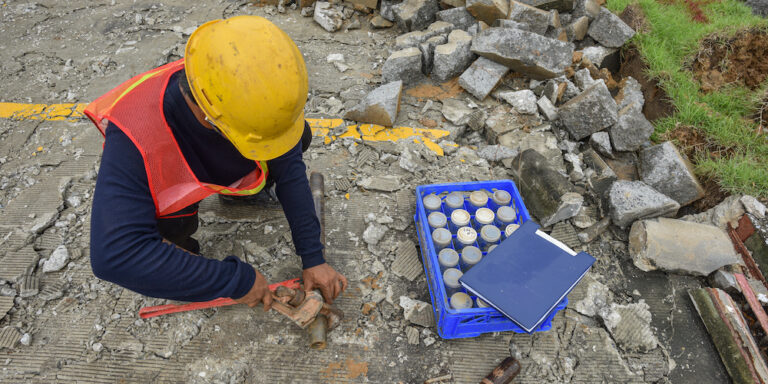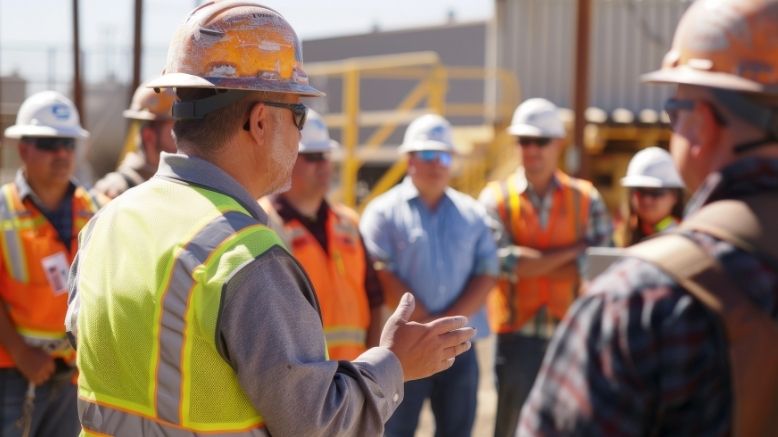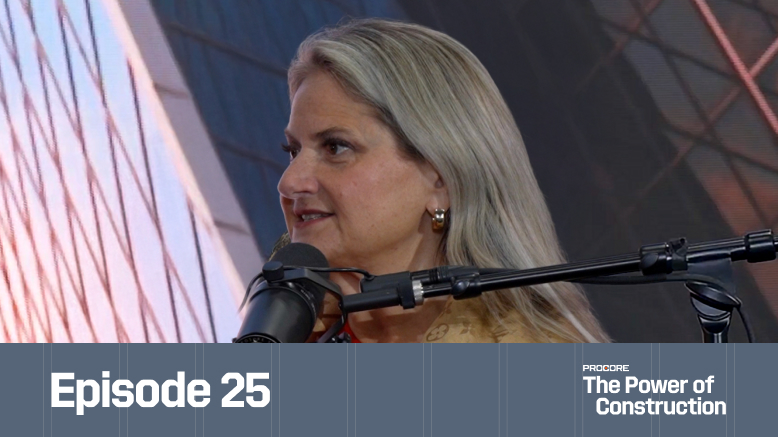— 8 min read
Unearthing Success: The Critical Role of Soil Testing for Construction


Last Updated May 10, 2024

Bryan Magargee
Senior Strategic Product Consultant, Owners
9 articles
Bryan Magargee is a Strategic Product Consultant for Procore with a decade of experience in construction project management where he managed achitects, contractors and engineers. Bryan is focused on implementing technology to streamline processes, production and efficiency.

Kacie Goff
Contributing Writer
89 articles
Kacie Goff is a construction writer who grew up in a construction family — her dad owned a concrete company. Over the last decade, she’s blended that experience with her writing expertise to create content for the Construction Progress Coalition, Newsweek, CNET, and others. She founded and runs her own agency, Jot Content, from her home in Ventura, California.
Last Updated May 10, 2024

For thousands of years, it's been said that a building constructed on a firm foundation will last. However, the foundation needs its own firm foundation. And that’s where soil testing for construction comes in.
With soil analysis, experts can determine if the earth below the building will provide the stable support the foundation — and the rest of the building — requires. By deploying soil testing for building construction, stakeholders take a critical step in doing due diligence when determining a project’s feasibility. This testing essentially gives them X-ray vision to see what’s happening underneath the ground. This way, they can uncover any issues and develop a plan to address them.
Table of contents
What is soil testing for construction?
In construction, soil testing (also known as "soils testing" as an alternative indicator of multiple types of soil) happens in the predevelopment phase. The project owner considering a specific parcel of land usually puts some money down (like earnest money on a home), enabling them to conduct some due diligence work around the property in question. In addition to soil testing, that might include:
- Talking with the local jurisdiction to understand code requirements and zoning
- Speaking with neighbors and homeowners associations (HOAs)
- Putting budgets into place
- Drafting preliminary drawings
As all of this happens, the owner investigates the project’s overall feasibility — sometimes even conducting a dedicated feasibility study. Soil testing for building construction is one part of the feasibility analysis, but it’s usually reported in its own document.
The goal behind soil analysis is to determine whether or not the earth below the planned building can support the structure. No matter how well a building’s foundation is constructed, elements like wind load, earth movement and more can impact the ground underneath it — assuming that soil hasn’t been properly prepared first.
Soil tests are often required by authorities having jurisdiction (AHJs) for code compliance for things like earthquakes, wind loads, flooding etc. The intent of soil testing is to provide a solid foundation for the structure to withstand any force majeure — ultimately, providing a safe structure that ideally will not fall down from poorly treated soil.
Many sites aren’t ready for development as-is, and optimizing the earth for construction might require some additional work tailored to the soil. If there’s a lot of granite present, for example, water will run off this non-porous rock and the owner might need to create a catch basin. Sandstone or pumice might eliminate the water collection issue but would be harder to build on because they’re both softer compounds.
Ultimately, soil testing for construction projects allows owners and other key players to discover what steps they need to take (if any) to prepare the earth for the planned building.
This soil analysis for construction might not be a one-and-done process, too. If the test discovers that the soil needs to be compacted to properly support the weight of the building, for example, compaction tests might be conducted repeatedly to ensure that it’s properly compacted all the way down to the required depth.
Types of Soil Testing for Building Construction
As a whole, any soil testing for building construction looks at the composition of the earth on the site. That means evaluating:
- Rock: The soil testing measures the type of rock on the land and its makeup (e.g., is it mixed into the soil or are there large granite boulders scattered throughout?).
- Water: This type of testing teaches owners about the sources of water (e.g., groundwater, runoff from nearby properties) and the current water content of the soil.
- Compact-ability: Soil testing for construction measures how much the soil can be compacted and how well it will compact (e.g., sand compacts well, but compacts best when it’s a mix of rounded and pointed sand particles).
Soil testing professionals get all of this information through a variety of different tests. Usually, soil analysis for construction consists of a mix of the following tests:
- Moisture content: This measures how much moisture currently exists in the soil and how well that soil type retains moisture. For example, a soil sample might be weighed, baked to remove all moisture and then weighed again to determine how much moisture was in the sample to start. Ultimately, experts have a variety of ways to measure moisture content as part of soil analysis for construction.
- Specific gravity: This test compares the density of the soil to the density of water. It evaluates whether the soil will absorb water and, if so, how quickly. This information informs proper planning for the building’s performance in heavy rains and floodwaters.
- Dry density: This gives experts a way to determine if the soil is dense, loose, or somewhere in the middle. With dry density testing, you learn how much space is between soil particles. This helps stakeholders determine how much compaction is needed to prepare the soil for the foundation and how much water can enter the site before the soil’s ability to support the structure is compromised.
- Atterberg limits: This type of soil testing for construction evaluates how soil performs under different moisture conditions. Experts look at whether it acts as a liquid (like water), solid (like an ice cube), semisolid (like a slushy), or plasticity, which means it’s solid but has stretch and memory (rather than being brittle).
- Proctor’s compaction: To conduct this test, experts dry the soil then divide it into samples. Varying amounts of water are added to each sample, which is then compacted. This determines the ideal moisture ratio to achieve the best level of compaction.
- Phase I and II environmental site assessment (ESA): While these assessments might evaluate the site beyond the soil (e.g., with groundwater sampling), they’re a key part of soil testing for construction because ESAs tell stakeholders about any hazardous soil conditions that could be present. A Phase I ESA usually means reviewing records for historical uses on the site that could impact the soil (e.g., past oil drilling on or near the parcel) and locating any aboveground or underground storage tanks. During phase II, experts take and test soil samples to look for contaminants.
- Shear strength: A soil's "shear strength" is indicative of its resistance to erosion. This kind of soil analysis for construction looks at how much stress the soil can bear before it breaks away from the surrounding earth. This becomes particularly important when building on a slope.
With all of these tests, owners can decide if the site they’re considering will support the structure they have envisioned.
The Process of Soil Testing
Soil testing starts when a licensed engineering firm takes soil samples. Because both soil conditions and the weather impacting the soil vary so much by geographic region, it’s important to find a firm that’s licensed in the jurisdiction where the project is planned. Plus, taking the necessary soil samples usually requires specialized equipment, and a properly licensed firm will already have what’s needed to collect soil.
The size, location, and condition of the parcel determine how many samples the firm collects and how deep they bore to obtain them. For a 3-acre lot, for example, they might take one or two dozen samples. If the soil testing is happening before an infrastructure project, the firm might take samples all along the planned road.
If the planned building is two stories, the firm may bore 20 feet down to collect samples. Before constructing a skyscraper, though, the firm may need to bore 100 feet or more into the ground to collect samples — often drilling down until hitting bedrock.
Once the engineering firm collects the required samples, it sends them to a lab. This process usually takes a month or longer between mailing in the samples and actually conducting the tests. In tandem, that firm might also pull historical soil tests from city records.
New technologies are beginning to speed up the lab portion of soil testing for building construction. While a human used to analyze samples under a microscope, some labs now use computers to analyze the soil more rapidly.
When the results are in, the engineering firm completes a soil testing report. Usually, that includes a recommendation to the owner. Often, an owner will hire an experienced construction manager or 3rd party consultant to analyze the report and provide specific use case recommendations based on the report findings.
The report developed after soil testing plays a key role in moving the project forward. AHJs won’t sign off on inspections until this piece is completed and the owner can show they’ve properly addressed any issues.
Addressing Issues Uncovered by Soil Testing
In many cases, owners will need to take an extra step to properly prepare their parcel for the building they have planned. Some of the options to address poor soil conditions include:
- Mixing something in the soil (e.g., concrete) to harden it
- Mixing something in the soil to improve its compatibility, then compacting it
- Removing the soil, letting it dry, putting it back in, and compacting it
- Removing the soil and replacing it with new soil
- Driving piles down to bedrock to support the foundation
- In the event of hazardous material in the soil, stripping it out, venting the parcel, and refilling it with new soil
Deploying soil analysis for construction is critical in ensuring that a firm foundation gets laid for the foundation — but it can add to a project’s soft costs. On one project in Colorado, for example, the soil analysis discovered permafrost. This required the owner to pivot to a different type of foundation — to the tune of $250,000.
If the work required to ready the soil would cost too much, the owner may choose to move the project to a different location or cancel it altogether. That’s why it’s so critical that soil testing for building construction happens during the predevelopment phase — ideally before the owner has purchased the property.
Was this article helpful?
Thank you for your submission.
95%
5%
You voted that this article was . Was this a mistake? If so, change your vote
Scroll less, learn more about construction.
Subscribe to The Blueprint, Procore’s construction newsletter, to get content from industry experts delivered straight to your inbox.
By clicking this button, you agree to our Privacy Notice and Terms of Service.
Thank you!
You’re signed up to receive The Blueprint newsletter from Procore. You can unsubscribe at any time.
Categories:
Written by

Bryan Magargee
Senior Strategic Product Consultant, Owners | Procore
9 articles
Bryan Magargee is a Strategic Product Consultant for Procore with a decade of experience in construction project management where he managed achitects, contractors and engineers. Bryan is focused on implementing technology to streamline processes, production and efficiency.
View profile
Kacie Goff
Contributing Writer | Procore Technologies
89 articles
Kacie Goff is a construction writer who grew up in a construction family — her dad owned a concrete company. Over the last decade, she’s blended that experience with her writing expertise to create content for the Construction Progress Coalition, Newsweek, CNET, and others. She founded and runs her own agency, Jot Content, from her home in Ventura, California.
View profileExplore more helpful resources

Unlocking Project Intelligence: Moving from Raw Data to Actionable Insights
The construction industry faces a wide range of challenges, from ongoing labor shortages to frequent cost overruns. But some the biggest hurdles all stem from unpredictability. The general contractors (GCs)...

Who is accountable for innovation in construction?
Everyone says construction needs to innovate—but no one agrees on who’s actually responsible for making it happen. Is it the owner? The builders? The tech vendor? Or is innovation everyone’s...

Integrated Project Delivery in Practice: A Framework for Collaboration
On construction projects, traditional delivery methods put different stakeholders in their own silos. While the design team feeds drawings and specifications to the general contractor (GC), the GC’s expertise in...

AI Construction Tools: Optimizing Every Stage of Construction
Builders, like everyone else, are being bombarded with information about incorporating AI into their work. However, determining which areas to automate can be challenging. This article explores the features of...
Free Tools
Calculators
Use our calculators to estimate the cost of construction materials for your next project.
Templates
Find a template to help you with your construction project tasks.
Material Price Tracker
Get the latest U.S. retail prices and view historical trends for common building materials.
Glossary
Explore key terms and phrases used in the industry.
